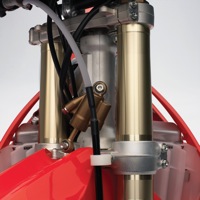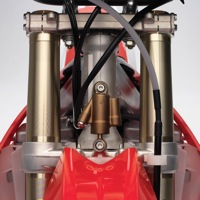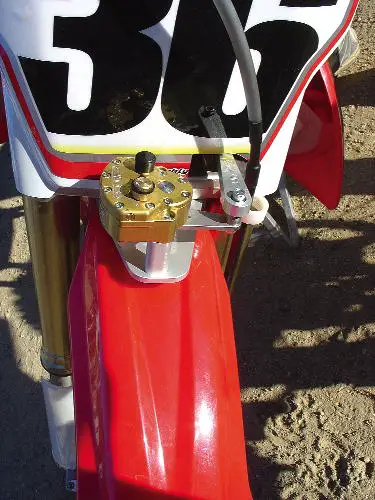TEN THINGS ABOUT STEERING DAMPERS



(1) Dynanics. The dynamics of steering a motorcycle have very little in common with the dynamics of steering an automobile. A rider stays balanced by overturning the bar to compensate for turning it too much in the opposite direction. As he does this, the bike’s geometry forces the wheel straight. In effect, the rider controls the bike through a nonstop tug-of-war between the steering forces and himself.

(2) Tug of war. A steering damper tones down the tug-of-war so that the rider doesn’t have to overreact. It reduces headshake and adds stability by keeping the front tire planted through the corners. Riders almost always prefer the way a bike handles with a steering damper, but often choose not to run one because they never warm up to the feel of resistance when the bars are turned at slow speed.
(3) Drag. Honda’s HPSD isn’t a pure steering damper. It is more of a metered drag device. It has no damping effect steering right to left for up to five degrees from dead center. After five degrees, the HPSD begins to absorb turning input with moderate damping. The level of damping is never very much, and the 20 clicks of adjustment don’t make much of a change in overall drag. The HPSD is designed to completely eliminate drag as the steering reaches full lock.
(4) Valve stack. Honda uses separate valve stacks to dampen steering movement in both directions. The return valve dampens softly in the beginning, as the steering turns back from the full-lock position. It progressively becomes firmer up until it returns to five degrees to either side of center. Then, it completely switches off. There is a bypass circuit, and from a practical point of view the damping is only effective during quick steering motions and swapping.
(5) HPSD weight. The HPSD was tested by the Honda race team for four years before it made it to the production bikes. Honda tucks the damper away behind the front number plate. There are a claimed 15 damping clicks, but most units have around 20. As a rule of thumb, most MXA test riders set the HPSD on the lightest possible setting for the conditions. The HPSD adds 6.9 ounces to the weight of the bike.
(6) Tuna. The most popular bolt-on steering damper is sold by Scotts Performance. While the HPSD looks like a mini shock absorber, the Scotts damper is the size of a can of tuna. It houses an aluminum wiper that sweeps across the oil-filled housing as the bars are turned.
(7) Dual direction. Scotts steering stabilizer (as they prefer to call it) is incredibly adjustable. It can dampen in both steering directions. It can be adjusted to dampen on the return stroke only. It can dampen the forces of turning away from the center line only. And it can dampen in all directions at all times. The Scotts damper can be mounted on top of the triple clamps or on the front fender. It weighs 20 ounces (with mounting bracket).
(8) Position-sensitive. The Scotts damper is position-sensitive. In its most popular setup, it knows where dead center is and in which direction the handlebar is being turned. It dampens when the bar is turned away from the center position. There is no damping turning back towards center. The Scotts damper controls the rider’s oversteer while directing the bike down the track.
(9) Base valve. The Scotts damper uses a base valve to adjust the level of resistance when turning away from the center line of the bike. As a rule, MXA test riders set it at eight clicks out. As a backup to the base valve, there is a high-speed valve (with a blow-off system) that flows more oil to ease sudden steering motion. The most common adjustment for the high-speed valve is 1-1/2 turns out.
(10) Sweep. Not only does the Scotts damper turn off the damping nearing full lock like the Honda HPSD, but it also allows the rider to adjust exactly when it free steers. It is called “sweep adjustment.” Most MXA test riders set the sweep at 34 degrees of total sweep (which is 17 degrees in either direction). Best of all, with the Scotts damper the damping can be turned off.





Comments are closed.